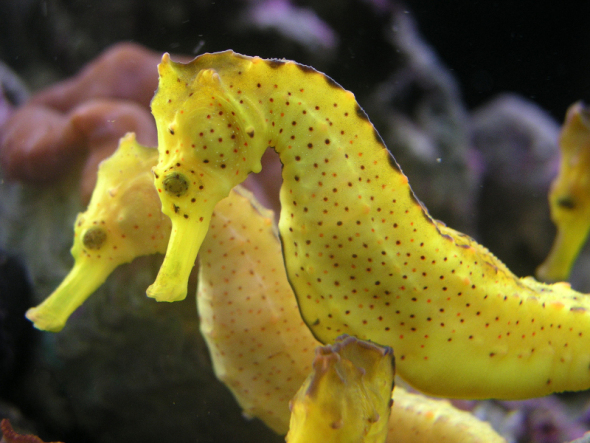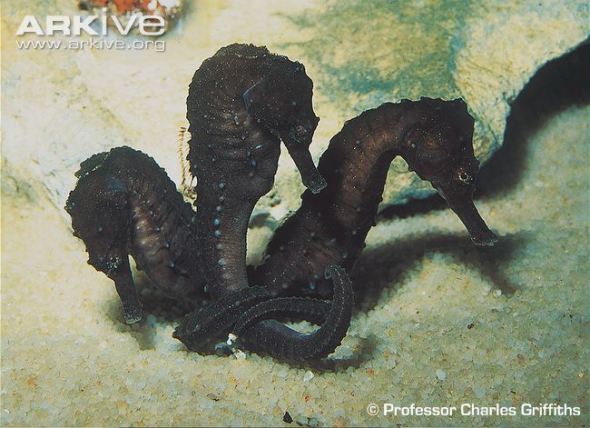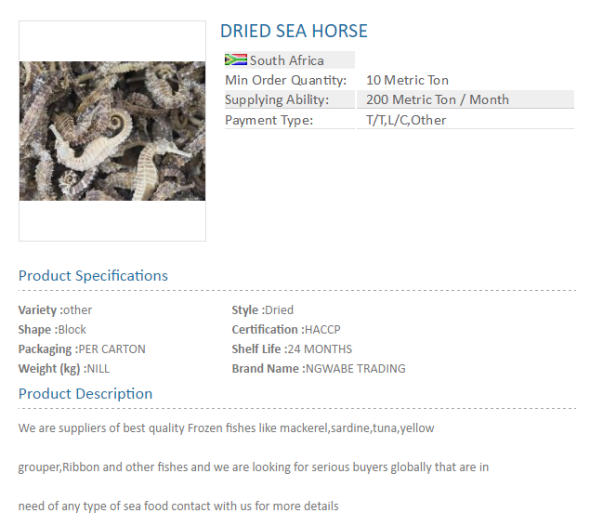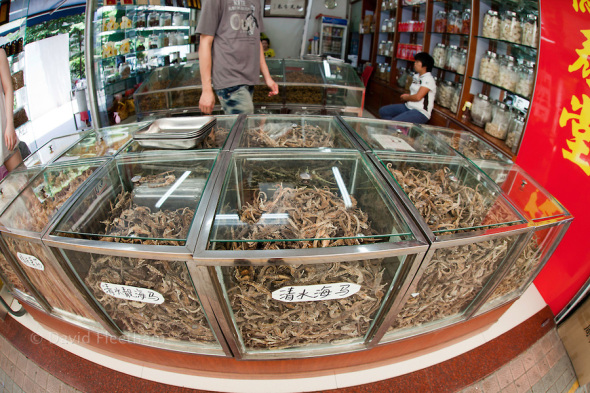ENDANGERED SPECIES MONDAY | SPOTTED SEAHORSE FACING EXTINCTION.

ENDANGERED SPECIES MONDAY | HIPPOCAMPUS KUDA
Once a common site within our oceans, the spotted seahorse (common seahorse) is facing extinction. The largest threat known is use and trade within the Traditional Chinese Medicine culture. As of 2015 its estimated that some twenty million (20 million) seahorses are used within the Traditional Chinese Medicine trade. (Photographer unknown).
Known in Mandarin as Hai Ma seahorses are believed to cure a wide spectrum of ailments and diseases and generally help to improve health. There is no evidence that I can locate to prove seahorses can improve human health in anyway shape or form. T.C.M practitioners have alleged seahorses can cure anything from asthma, arteriosclerosis, incontinence, impotence, insomnia, thyroid disorders, skin ailments, broken bones, heart disease, throat infections, abdominal pain, sores, skin infections.
Broken bones? Now that is about as ridiculous as it gets, impotence and broken bones are not illnesses but more physical complaints of which consuming seahorses is about as effective as pouring boiling hot water onto a third degree burn. A study in Taiwan located some fifty eight (58) sea horses from Taiwanese T.C.M vendors. A total of eight (8) different species were located. Seven (7) were listed as vulnerable, while one (1) was listed as endangered.
Source: http://www.jfda-online.com/article/S1021-9498(13)00043-4/abstract
The species listed as endangered was Hippocampus capensis commonly known as the Knysna seahorse (pictured below). The remaining seven (which doesn’t include the species pictured above) are scientifically identified as Hippocampus algiricus, Hippocampus comes, Hippocampus histrix, Hippocampus kelloggi, Hippocampus kuda, Hippocampus spinosissimus, and Hippocampus trimaculatus. If we include the species above - Hippocampus kuda this makes a total of eight (8) listed as vulnerable, and one (1) listed as endangered equating to nine (9) in total nearing extinction.

Image: Knysna seahorses | Credits Professor Charles Griffiths
Its quite possible there could be many more species of sea horses that haven’t been listed on the International Union for the Conservation Of Natures Red List [IUCN]. Hippocampus kuda was identified back by Dr Pieter Bleeker (July 10, 1819, Zaandam – January 24, 1878, from The Hague) whom was a Dutch medical doctor, ichthyologist, and herpetologist.
He was famous for the Atlas Ichthyologique des Orientales Neerlandaises, his monumental work on the fishes of East Asia published between 1862 and 1877. I don’t state this often however am going to repeat oneself again. Every single species of animal I’ve written about identified from the (1800’s) has almost all but gone extinct or are at least on their way towards extinction. Another pattern I have found is that many animals and plants used within the (T.C.M) trade were being used thousands of years ago - long before non-Asian travelers identified them. When the species are eventually identified - individual specie populations begin declining!
Since 1996-2003 the common seahorse has been listed as vulnerable, populations are declining very fast, furthermore there was little mentioned about the species at CoP17 in Johannesburg, South Africa; a country that is responsible for a large proportion of seahorse harvests. These harvests are legally shipped from South Africa into Asia, yet large numbers of seahorses are decreasing in South Africa.
I.A.R.F.A Environmental Crime Investigators located one legal trader identified as NGWABE TRADING that hosts a supplying ability of TWO HUNDRED METRIC TONS a month. When we inquired where these seahorses are harvested from, and the species caught we were not given a straightforward answer. NGWABE TRADING was though able to supply us with seahorses that have paperwork (all allegedly legal and above-board.) Yet we’re losing the vast majority of our seahorses. Furthermore I am very suspicious as to whether all of these seahorses are being harvested legally.
Two hundred metric tons per month is no different to two hundred metric tons of sand, cement, or rocks. On questioning the fishing company which I myself do suspect illegal poaching is going on here, many of these seahorses are dry traded to Asia. We’re talking big bucks too. So if this trade was restricted, or even banned, its likely South Africa would lose her seahorses in a matter of years, because legal farming operations wouldn’t be allowed if trade bans came into place. Meaning poaching would increase on a wide scale to supply Asia’s appetite for pseudo medicines.
Source: http://southafrica.tradekey.com/dried-sea-horses.htm

Image: One of many legal online seahorse/fish traders trading to Asia.
Seahorses are also used as an aphrodisiac and to facilitate childbirth in the T.C.M trade. As much as I want to disbelieve this, there is unfortunately “some scientific evidence” that does prove to a degree consuming a regular fish diet can improve sexual behavior within humans; however helping to conceive I am somewhat skeptical about. Sources are cited below for your information from the scientific community.
Source 1: http://www.pbs.org/wgbh/nova/seahorse/vincent.html
Source 2: http://www.acupuncturetoday.com/herbcentral/sea_horse.php
Between twenty (20) and forty (40) million seahorses are allegedly harvested every-year for the T.C.M trade, however if we go on the amount of trade originating from South Africa - its obvious that by the ton load this number is seriously under-quoted. If I myself was purchasing the minimum ton load of ten (10) tons per month - that would easily equate to over twenty (20) and forty (40) million seahorses per annum based on twelve (12) months.
So I think its safe to say we’re looking at possibly hundreds of millions rather than the claimed IUCN stats. I must also note that the spotted seahorse is listed on Appendix II, and to date we will never really know how many seahorses remain within their endemic range, or how many are illegally harvested?
The common seahorse in question which is the species harvested the most for the T.C.M trade is endemic to the following regions: American Samoa (American Samoa); Australia (Northern Territory, Queensland); Bahrain; Cambodia; Fiji; French Polynesia; Hong Kong; India; Indonesia; Japan; Kuwait; Malaysia; Micronesia, Federated States of ; Mozambique; New Caledonia; Pakistan; Papua New Guinea; Philippines; Saudi Arabia; Singapore; Solomon Islands; South Africa (KwaZulu-Natal); Taiwan, Province of China; Tanzania, United Republic of; Thailand; Tonga; United States (Hawaiian Is.); and Viet Nam.
Endemic ocean locations are: Indian Ocean – western; Indian Ocean – eastern; Pacific – western central; Pacific – northwest; Pacific – eastern central.

Image: Dried Seahorses for sale, China | Credits David Fleetham
THREATS
Common threats are cited above in more detail. Major threats though are listed below for your immediate attention:
Hippocampus kuda is threatened by damage to its habitats from coastal development and destructive fishing practices. Land-based activities such as coastal construction can diminish seagrass beds and mangroves while leading to increased pollution and siltation in surrounding marine waters. For example, in Malaysia Hippocampus kuda numbers declined due to an extensive port development around the Pulai Estuary that destroyed large tracts of seagrass meadow.
Fishing methods such as trawling result in substantial damage to seagrass beds globally, and especially in the Indo-Pacific. The decline in and fragmentation of the species’ habitats throughout its range indicates possible declines in populations in addition to those caused by fisheries.
All seahorse species have vital parental care, and many species studied to date have high site fidelity, highly structured social behaviour, and relatively sparse distributions. These life history parameters often make species susceptible to exploitation as has been demonstrated for a number of species, including seahorses. Although seahorses also have some traits, such as small body size, fast growth and high fecundity, that may confer resilience to exploitation pressures.
Due to the mode of spawning exhibited by Hippocampus kuda (ovoviviparous brood pouch male parental care), fecundity is comparatively low compared to non-brood pouch spawning fishes and therefore its capacity for population growth is more limited than other species. As a result of the lack of broadcast spawning of pelagic eggs, dispersal of potential recruits is limited. Additionally, given the limited swimming abilities of seahorses, it is highly unlikely that rescue effects would occur from adjacent populations.
Concluding: I am somewhat concerned about the species future survival. CITES is allowing use and trade however those countries that are listed under the convention are allegedly strictly regulated and monitored - I don’t call ten tons per month from one South African company strict regulation. Countries that are importing/exporting must prove they have permits, however I don’t quite understand how this area of monitoring is working - which it clearly isn’t as the seahorse trade is colossal within many Asian countries and South Africa too.
Hippocampus kuda is listed as vulnerable in the National Red Data Books of Singapore and Thailand, and endangered in the Red Data Book of Viet Nam. In France it is illegal to import seahorses under the name H. kuda.
The future is bleak unfortunately and with trade so fanned out, and from what I have seen on my visits to Asia (increasing) I do honestly believe we’re going to be reporting extinctions in the ‘very near future.’ To date there are thirty two (32) identified species of seahorses. Ecologically, they are important in food chains, consuming tiny fish, small shrimp, and plankton, and being consumed by larger fish (such as tuna and rays) and crabs. So if we lose the seahorse we lose yet another vital source of food for endangered tuna species, rays, crabs, and even whales (Etc.)
Source: http://www.newworldencyclopedia.org/entry/Seahorse
Thank you for reading and please share to create awareness and to improve education.
Dr Jose C. Depre.
Environmental, Botanical & Human Scientist.
www.speakupforthevoiceless.org


